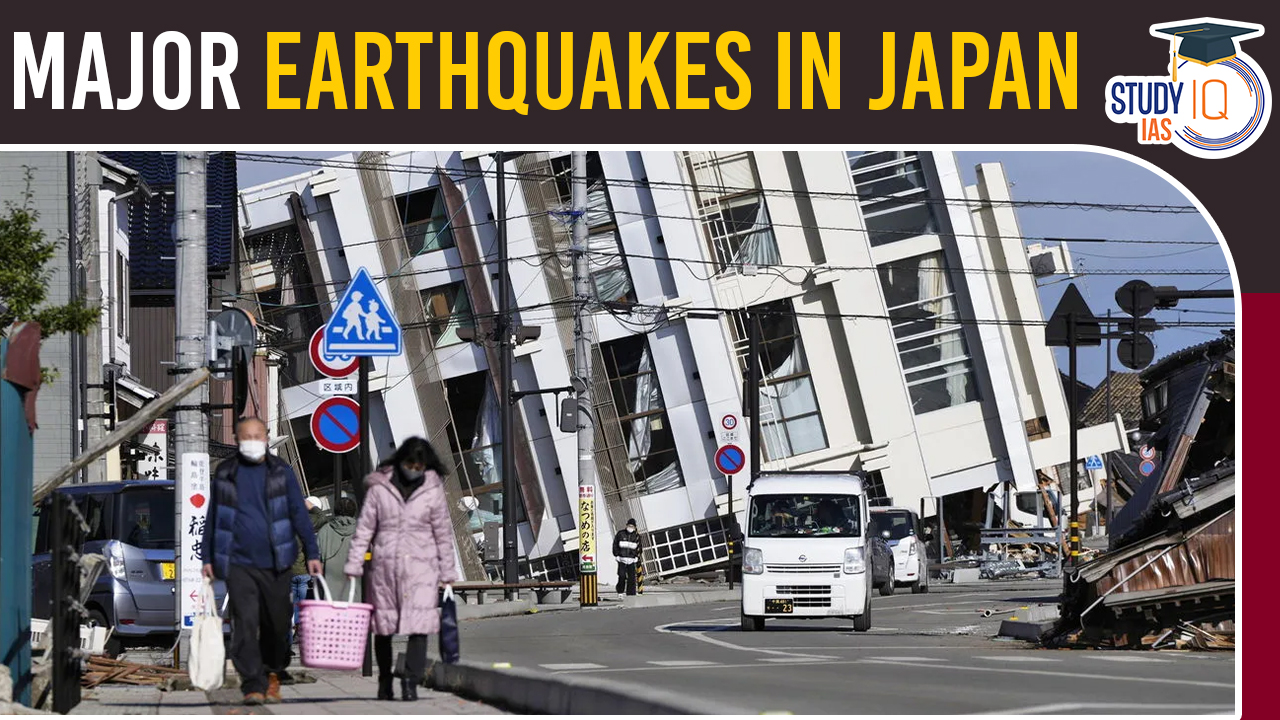Table of Contents
On January 13, 2025, a magnitude 6.9 earthquake struck southwestern Japan, with its epicentre in the Hyuga-Nada Sea near Miyazaki Prefecture. The quake occurred at 9:19 p.m. local time. It prompted the Japan Meteorological Agency (JMA) to issue a tsunami advisory for the Miyazaki and Kochi prefectures, warning of possible tsunami waves up to 1 meter. Following the earthquake, evacuation orders were issued in 11 cities within Kochi Prefecture; these orders were later lifted.
Japan, positioned along the notorious “Ring of Fire,” characterized by a series of active volcanoes and tectonic plate boundaries encircling the Pacific Basin, is prone to frequent and intense seismic activity. Approximately 20% of the world’s earthquakes with a magnitude of 6 or higher occur in this region, amounting to around 2,000 perceptible quakes annually. This article will give you a List of Major Earthquakes in Japan.
History of Earthquakes in Japan
Japan has a long history of seismic activity, with earthquakes playing a significant role in shaping the nation’s landscape. The country sits on the Pacific Ring of Fire, a zone known for high tectonic activity. One of the most devastating earthquakes was the Great Kanto Earthquake in 1923, which caused widespread destruction and claimed over 140,000 lives.
The 2011 Tohoku earthquake and tsunami were also catastrophic, triggering a nuclear disaster in Fukushima. Japan continually implements advanced seismic technology and strict building codes to mitigate earthquake risks, showcasing its resilience in the face of natural challenges.
Check here: Earthquakes in India
List of Major Earthquakes in Japan
Japan is situated in a seismically active region, and its history is marked by numerous earthquakes that have had profound impacts on the country. Here are some significant earthquakes in Japan’s history:
| Year | Earthquake Name | Magnitude | Impact |
| 1498 | Meio Nankai Earthquake | 8.6-9.1 | Massive tsunami with waves reaching the Philippines |
| 1854-1855 | Ansei Edo Earthquakes (series of three) | 7.0-7.3 | Widespread damage and fires in the Edo region |
| 1923 | Great Kanto Earthquake | 7.9 | Devastation in Tokyo and Yokohama, 140,000+ casualties |
| 1944 | Showa Nankai Earthquake | 7.9 | Tsunami causing significant damage in Tokushima, Kochi |
| 1959 | Ise Bay Typhoon and Earthquake | Not Applicable | Landslides and debris flows after Typhoon Vera |
| 1964 | Niigata-Chuetsu Earthquake | 7.5 | Widespread damage to buildings and infrastructure |
| 1995 | Kobe Earthquake (Great Hanshin Earthquake) | 6.9 | Over 6,400 casualties, extensive infrastructure damage |
| 2011 | Tohoku Earthquake and Tsunami | 9.0 | Mega-thrust earthquake, powerful tsunami, Fukushima disaster |
| 2021-2022 | Fukushima Earthquakes (series) | Various | Including a magnitude 7.3 quake in 2021 and 2022 |
Details about Major Earthquakes in Japan
- Nankai Earthquake (1498): Often referred to as the Meio Nankai Earthquake, this event had an estimated magnitude of 8.6–9.1 and triggered a massive tsunami. The tsunami waves reached as far as the Philippines.
- Ansei Edo Earthquakes (1854-1855): A series of three major earthquakes struck the Edo (now Tokyo) region during this period. The most destructive was the Ansei Edo earthquake in 1855, which had a magnitude of 7.0-7.3. These earthquakes caused widespread damage and fires.
- Great Kanto Earthquake (1923): With a magnitude of 7.9, this devastating earthquake struck the Kanto region, including Tokyo and Yokohama. The quake and ensuing fires resulted in the deaths of over 140,000 people.
- Showa Nankai Earthquake (1944): This earthquake, with a magnitude of 7.9, occurred off the coast of Nankai. It generated a tsunami that caused significant damage along the coasts of Tokushima and Kochi.
- Ise Bay Typhoon and Earthquake (1959): In the aftermath of Typhoon Vera, which struck Japan in September 1959, heavy rainfall triggered a series of landslides in the Ise Bay region. The resulting debris flows caused the death of over 5,000 people.
- Niigata-Chuetsu Earthquake (1964): With a magnitude of 7.5, this earthquake struck the Niigata region, causing widespread damage to buildings and infrastructure. It was notable for its effects on the engineering community’s approach to seismic design.
- Kobe Earthquake (1995): The Great Hanshin Earthquake, with a magnitude of 6.9, struck near Kobe and Awaji Island. It resulted in the deaths of over 6,400 people and caused extensive damage to infrastructure, highlighting vulnerabilities in urban planning and construction.
- Tohoku Earthquake and Tsunami (2011): This mega-thrust earthquake, with a magnitude of 9.0, triggered a powerful tsunami that struck the northeastern coast of Japan. The Fukushima Daiichi nuclear disaster was also a consequence of this event. It is considered one of the most powerful earthquakes recorded.
- Fukushima Earthquakes (2021-2022): A series of earthquakes struck off the coast of Fukushima in 2021 and 2022, including a magnitude 7.3 quake in February 2021 and another with a magnitude of 7.3 in March 2022. These events revived concerns about nuclear safety and earthquake preparedness.
These earthquakes illustrate the seismic risk faced by Japan and the ongoing efforts to understand, mitigate, and respond to the challenges posed by such natural disasters. The country has implemented stringent building codes, early warning systems, and disaster preparedness measures to minimize the impact of future seismic events.
We’re now on WhatsApp. Click to Join
Japan’s Biggest Earthquakes
The strongest earthquake in Japan’s recorded history occurred on March 11, 2011. The 9.1 magnitude earthquake struck 130 kilometres east of Sendai, the largest city in the Tohoku region. The earthquake triggered a tsunami that killed nearly 20,000 people and caused a nuclear meltdown in Fukushima. The disaster is estimated to have caused $220 billion in damage.
Top 5 Largest Earthquakes in Japan
| Rank | Earthquake Name | Magnitude | Date | Impact |
| 1 | Tohoku Earthquake and Tsunami (2011) | 9.0 | March 11, 2011 | Mega-thrust earthquake, powerful tsunami, Fukushima Daiichi nuclear disaster |
| 2 | Showa Nankai Earthquake (1944) | 7.9 | December 7, 1944 | Off the coast of Nankai, generated a tsunami, significant damage along Tokushima and Kochi coasts |
| 3 | Great Kanto Earthquake (1923) | 7.9 | September 1, 1923 | Devastated Tokyo and Yokohama, over 140,000 casualties, widespread destruction |
| 4 | Niigata-Chuetsu Earthquake (1964) | 7.5 | June 16, 1964 | Affected Niigata region, widespread damage to buildings, influenced seismic design |
| 5 | Meio Nankai Earthquake (1498) | Estimated 8.6-9.1 | August 20, 1498 | Massive tsunami, waves reaching the Philippines, extensive coastal damage |


 SSC MTS Salary 2025, Check Highest Salar...
SSC MTS Salary 2025, Check Highest Salar...
 F-35 Fighter Jet Stranded in Kerala: Dis...
F-35 Fighter Jet Stranded in Kerala: Dis...
 Quad Summit 2025: Key Announcements, Str...
Quad Summit 2025: Key Announcements, Str...





















